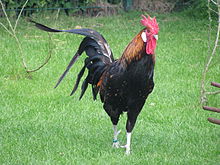Bergische Kräher
 | |
| Conservation status | |
|---|---|
| Country of origin | Germany |
| Traits | |
| Weight | |
| Egg colour | white |
| Comb type | single |
| Classification | |
| EE | yes[3] |
| PCGB | rare long crowers[4] |
| |
The Bergische Kräher[a] is a German breed of domestic chicken from the Bergisches Land, in the state of North Rhine-Westphalia in western Germany.[2][5] It is named for its unusually long crow, up to five times as long as that of other breeds, and belongs to the group of long-crowing chicken breeds, which are found from south-east Europe to the Far East.[6]
History
[edit]

The Bergische Kräher has been bred in the Bergisches Land for hundreds of years, and there are various myths about its origins.[7] It was probably brought there from south-east Europe or the Middle East at the time of the Crusades, and may have been spread through the area by Cistercian monks.[6] It is closely related to the Bergische Schlotterkamm[8]: 14 [9]: 134 . Crowing contests were held for the birds, and they were selectively bred for their crowing ability.[6] A breed association, the Kräherzüchtervereinigung, was founded in 1884,[8] and the first breed standard dates from 1885.[10]: 333
Today the Bergische Kräher is a rare breed. In 2001 it was an "endangered breed of the year" of the Gesellschaft zur Erhaltung alter und gefährdeter Haustierrassen,[11] and is listed in category I: extrem gefährdet, "extremely endangered", on the Rote Liste of that organisation.[12] In 2009, 77 cocks and 337 hens were recorded;[13] in 2013 the total population was 329.[5]
Characteristics
[edit]Only one plumage colouring is recognised, gold-laced black.[3][10]: 333 Hen birds are black with some gold markings on the wings and breast; cocks have gold neck-hackles and maroon markings on the wings. The black colour variety is extinct, black-silver coloured birds are extremely rare.[8] Like the Bergische Schlotterkamm, the Bergische Kräher shows typical broad lacing ("Dobbelung") of the breast feathers.[7] Cocks weigh 3–3.5 kg and hens 2–2.5 kg. The comb is single, the earlobes are white, and the legs are slate-blue.[7][10]: 333
Use
[edit]The Bergische Kräher is a dual-purpose breed, with good meat qualities. Hens lay about 130 white eggs per year, with an average weight of 56 g;[2] they have little tendency to broodiness.[6]
Cock crowing contests with Bergische Krähers have been a sport in the Bergische Land for centuries.[14] Since 1923, the breed society has organised annual crowing contests on Ascension Thursday[8]. In these – unlike in most traditional cock crowing contests in Germany, the Netherlands and Belgium – the crow is judged for its length and beauty, rather than for its frequency.[15]
-
Hen
-
The typical broad lacing (Dobbelung) of the breast feathers
-
Historical Illustration, Jean Bungartz, 1885
Notes
[edit]- ^ pronounced [ˈbɛʁɡɪʃə ˈkʁɛːɐ]; translatable as "crower of the Bergisches Land"
References
[edit]- ^ Barbara Rischkowsky, D. Pilling (eds.) (2007). List of breeds documented in the Global Databank for Animal Genetic Resources, annex to The State of the World's Animal Genetic Resources for Food and Agriculture. Rome: Food and Agriculture Organization of the United Nations. ISBN 9789251057629. Accessed January 2017.
- ^ a b c d Rassetafeln: Bergische Kräher (in German). Bund Deutscher Rassegeflügelzüchter. Accessed August 2014.
- ^ a b Liste des races et variétés homologuée dans les pays EE (28.04.2013). Entente Européenne d’Aviculture et de Cuniculture. Archived 16 June 2013.
- ^ Breed Classification. Poultry Club of Great Britain. Archived 12 June 2018.
- ^ a b Breed data sheet: Bergische Kräher/Germany. Domestic Animal Diversity Information System of the Food and Agriculture Organization of the United Nations. Accessed August 2014.
- ^ a b c d Bergische Kräher (in German). Gesellschaft zur Erhaltung alter und gefährdeter Haustierrassen. Accessed January 2017.
- ^ a b c Schwerpunkt - Geflügel: Bergische Kräher (in German). Gesellschaft zur Erhaltung alter und gefährdeter Haustierrassen. Accessed August 2014.
- ^ a b c d Armin Six (2015). Bergische Kräher (in German). Gesellschaft zur Erhaltung alter und gefährdeter Haustierrassen. Accessed May 2019.
- ^ Edward Brown (1906). Races of Domestic Poultry. London: Edward Arnold.
- ^ a b c Victoria Roberts (2008). British poultry standards: complete specifications and judging points of all standardized breeds and varieties of poultry as compiled by the specialist breed clubs and recognised by the Poultry Club of Great Britain. Oxford: Blackwell. ISBN 9781405156424.
- ^ Die gefährdete Nutztierrasse des Jahres 2001 (in German). Gesellschaft zur Erhaltung alter und gefährdeter Haustierrassen. Archived 23 November 2016.
- ^ Gemeinsame Liste alter und einheimischer Geflügelrassen in Deutschland der GEH und des BDRG (in German). Gesellschaft zur Erhaltung alter und gefährdeter Haustierrassen. Archived 2 February 2017.
- ^ Rote Liste: Einheimische Nutztierrassen in Deutschland 2013 (in German). Bundesanstalt für Landwirtschaft und Ernährung. Archived 1 February 2014.
- ^ Friedrich Wieden (1949). Die Geschichte der Bergischen Kräher. Deutscher Geflügelhof 43. Oldenburg.
- ^ Stefaan De Groote (27 June 2011). Hanenzettingen opgenomen in Vlaamse inventaris immaterieel erfgoed (in Dutch, "Cock crowing contest recognised as Flemish national heritage"). Het Nieuwsblad. Accessed October 2015.



